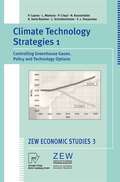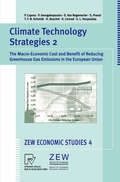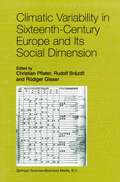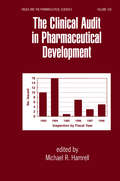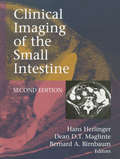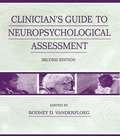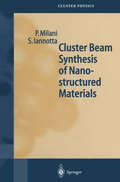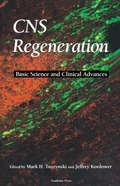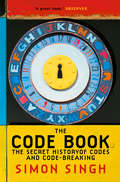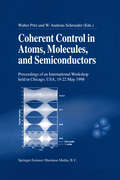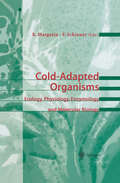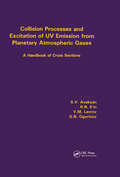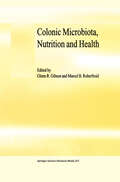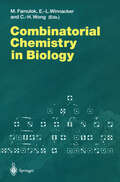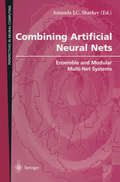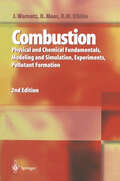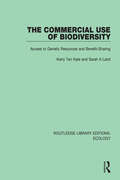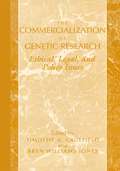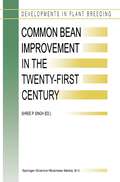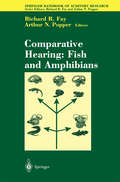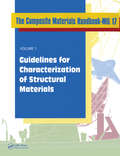- Table View
- List View
Climate Technology Strategies 1: Controlling Greenhouse Gases. Policy and Technology Options (ZEW Economic Studies #3)
by Pantelis Capros Leonidas Mantzos Patrick Criqui Nikolaos Kouvaritakis Antonio Soria Ramirez Leo Schrattenholzer E.Lakis VouyoukasClimate Technology Strategies 2: The Macro-Economic Cost and Benefit of Reducing Greenhouse Gas Emissions in the European Union (ZEW Economic Studies #4)
by Pantelis Capros Panagiotis Georgakopoulos Denise van Regemorter Stef Proost Tobias F.N. Schmidt Henrike Koschel Klaus Conrad E.Lakis VouyoukasClimate technology becomes more and more relevant in international environmental policy negotiations. At the Kyoto conference binding emission reduction targets have been established for several regions of the world. The major challenge is how to realize these reduction goals with minimum costs without generating new distributional and social difficulties. The book analyses the macroeconomic structural and distributional impacts of greenhouse gas mitigation strategies for the EU and the member states.
Climatic Variability in Sixteenth-Century Europe and Its Social Dimension
by RüdigerGlaser RudolfBrázdil ChristianPfisterA multidecadal cooling is known to have occurred in Europe in the final decades of the sixteenth-century. It is still open to debate as to what might have caused the underlying shifts in atmospheric circulation and how these changes affected societies. This book is the fruit of interdisciplinary cooperation among 37 scientists including climatologists, hydrologists, glaciologists, dendroclimatologists, and economic and cultural historians. The known documentary climatic evidence from six European countries is compared to results of tree-ring studies. Seasonal temperature and precipitation are estimated from this data and monthly mean surface pressure patterns in the European area are reconstructed for outstanding anomalies. Results are compared to fluctuations of Alpine glaciers and to changes in the frequency of severe floods and coastal storms. Moreover, the impact of climate change on grain prices and wine production is assessed. Finally, it is convincingly argued that witches at that time were burnt as scapegoats for climatic change.
The Clinical Audit in Pharmaceutical Development
by Michael HamrellThis blue-chip guide adds quality to the pharmaceutical clinical development process by detailing the need for, and stressing the importance of, an independent audit of clinical data to protect participants and validate study results.Examines the use of personal computers, the Internet, and third-party organizations to assist in data validation
Clinical Imaging of the Small Intestine
by Emil J. Balthazar Hans Herlinger Dean Maglinte Bernard A. BirnbaumClinical Imaging of the Small Intestine offers a complete review of small bowel radiology and its applications. With contributions from leading international authorities, the book provides the reader with the pertinent aspects of gastrointestinal radiology, specifically the problems of technique and interpretation that confront radiologists.The second edition was revised to include: - CT and MRI of the small bowel; - Sonography of the small bowel; - Assessing the activity of Crohn's disease with MRI; - Vascular disorders and small bowel obstructions; - Immune deficiency diseases; - Differential diagnosis based on both pathologic and radiologic findings; - New Figures and expanded index.The comprehensive scope of coverage makes this book a highly specialized but nonetheless state-of-the-art reference for those practitioners who have an interest in learning more about intestinal imaging, including radiologists, gastroenterologists and surgeons.
Clinician's Guide To Neuropsychological Assessment
by Rodney D. VanderploegNeuropsychological assessment is a difficult and complicated process. Often, experienced clinicians as well as trainees and students gloss over fundamental problems or fail to consider potential sources of error. Since formal test data on the surface appear unambiguous and objective, they may fall into the habit of overemphasizing tests and their scores and underemphasizing all the factors that affect the validity, reliability, and interpretability of test data. But interpretation is far from straightforward, and a pragmatic application of assessment results requires attention to a multitude of issues. This long-awaited, updated, and greatly expanded second edition of the Clinician's Guide to Neuropsychological Assessment, like the first, focuses on the clinical practice of neuropsychology. Orienting readers to the entire multitude of issues, it guides them step by step through evaluation and helps them avoid common misconceptions, mistakes, and methodological pitfalls. It is divided into three sections: fundamental elements of the assessment process; special issues, settings, and populations; and new approaches and methodologies. The authors, all of whom are actively engaged in the clinical practice of neuropsychological assessment, as well as in teaching and research, do an outstanding job of integrating the academic and the practical. The Clinician's Guide to Neuropsychological Assessment, Second Edition will be welcomed as a text for graduate courses but also as an invaluable hands-on handbook for interns, postdoctoral fellows, and experienced neuropsychologists alike. No other book offers its combination of breadth across batteries and approaches, depth, and practicality.
Clinician's Guide To Neuropsychological Assessment
by Rodney D. VanderploegNeuropsychological assessment is a difficult and complicated process. Often, experienced clinicians as well as trainees and students gloss over fundamental problems or fail to consider potential sources of error. Since formal test data on the surface appear unambiguous and objective, they may fall into the habit of overemphasizing tests and their scores and underemphasizing all the factors that affect the validity, reliability, and interpretability of test data. But interpretation is far from straightforward, and a pragmatic application of assessment results requires attention to a multitude of issues. This long-awaited, updated, and greatly expanded second edition of the Clinician's Guide to Neuropsychological Assessment, like the first, focuses on the clinical practice of neuropsychology. Orienting readers to the entire multitude of issues, it guides them step by step through evaluation and helps them avoid common misconceptions, mistakes, and methodological pitfalls. It is divided into three sections: fundamental elements of the assessment process; special issues, settings, and populations; and new approaches and methodologies. The authors, all of whom are actively engaged in the clinical practice of neuropsychological assessment, as well as in teaching and research, do an outstanding job of integrating the academic and the practical. The Clinician's Guide to Neuropsychological Assessment, Second Edition will be welcomed as a text for graduate courses but also as an invaluable hands-on handbook for interns, postdoctoral fellows, and experienced neuropsychologists alike. No other book offers its combination of breadth across batteries and approaches, depth, and practicality.
Cluster Beam Synthesis of Nanostructured Materials (Springer Series in Cluster Physics)
by Paolo Milani Salvatore IannottaThis book supplies a systematic description of the preparation, characterization, and manipulation of cluster beams for the synthesis of nanocrystalline materials. It addresses all issues relevant to the realization of nanophase structures, providing an excellent introduction for scientists working in different fields. Particular emphasis is placed on using the technique for nanostructured materials and on explaining the role of cluster beams within the context of other experimental techniques in surface-science.
CNS Regeneration: Basic Science and Clinical Advances
by Mark H. Tuszynski Jeffrey KordowerCNS Regeneration focuses on some of the leading current neurological disease models and methods for promoting central nervous system regeneration. Editors and authors are experts in the field, with experience in basic as well as applied neuroscience. In a comprehensive, logical manner, the book unites important basic science advances in neuroscience with novel medical strategies.The first comprehensive, authoritative volume on the topic of CNS regenerationReviews current therapeutic approachesEditors and authors are experts in the fieldAppeals to those interested in basic science as well as those concerned with its medical application
The Code Book: The Secret History Of Codes And Code-breaking
by Simon SinghThe Science of Secrecy from Ancient Egypt to Quantum Cryptography From the best-selling author of Fermat’s Last Theorem, The Code Book is a history of man’s urge to uncover the secrets of codes, from Egyptian puzzles to modern day computer encryptions.
Coherent Control in Atoms, Molecules, and Semiconductors
by Walter Pötz W. Andreas SchroederThe International Workshop on Coherent Control of Carrier Dynamics in Semiconductors was held May 19 to 22, 1998 at the University of Illinois at Chicago. Its intent was to bring together an international and interdisciplinary group of scientists to discuss recent progress, pertinent problems, and open questions in the field of coherent control in atoms, molecules, and semiconductors, in particular. Twenty-seven scientists from the physical chemistry, quantum optics, semiconductor, electrical engineering, and laser communities accepted our invitation and made this event a meeting of exciting presentations and vivid discussions. This volume contains the proceedings of this workshop. Most speakers accepted our invitation to provide a manuscript either on specific aspects of their work or a brief review of their area of research. All manuscripts were reviewed. It is hoped that they provide not merely an overview of most of the issues covered during the workshop, but also represent an account of the current state of coherent control in general. Hence, it is hoped that they are also of interest to a large number of scientists active in one of the areas listed above. The organizers of this workshop would like to thank all the participants for making this meeting a complete success. We are particularly indebted to Dr. Larry R. Cooper at the U.S. Office of Naval Research and Dr.
Cold-Adapted Organisms: Ecology, Physiology, Enzymology and Molecular Biology
by Rosa Margesin Franz SchinnerRepresenting the latest knowledge of the ecology and the physiology of cold-adapted microorganisms, plants and animals, this book explains the mechanisms of cold-adaptation on the enzymatic and molecular level, including results from the first crystal structures of enzymes of cold-adapted organisms.
Collision Processes and Excitation of UV Emission from Planetary Atmospheric Gases: A Handbook of Cross Sections
by SV AvakyanOver the past few decades, the excitation and ionization of atmospheric gases has become an area of intense research. A large amount of data have been accumulated concerning the various elementary processes which occur when photons, electrons and ions collide with atoms and molecules. This scattered information has now been collected in a handbook for the first time, and the authors give a critical analysis of relevant data. This book is a comprehensive and detailed study of the available information and is distinguished by the following outstanding features: the consideration of a large number of atmospheric constituents, including H^O2, H, N^O2, N, O^O2, O, CO, CO^O2, H^O2O, HCl and some hydrocarbons the maximum number of space particles, including magnetospheric particles, are considered as projectiles: photons, electrons, hydrogen atoms, protons and helium ionsthe energy range under study corresponds to the real spectrum of cosmic fluxes, from threshold values for elementary processes up to several thousand keV the recommended values of cross sections, obtained from analysis of the available experimental data, are given in the handbook and their accuracy is estimated. These features make the handbook particularly valuable to specialists in the aeronomy of planets, comets and active perturbations, as well as to experimentalists and theoreticians working in the fields of plasma physics, atomic and molecular physics, physics of the upper atmosphere, chemical physics, optics and spectroscopy.
Collision Processes and Excitation of UV Emission from Planetary Atmospheric Gases: A Handbook of Cross Sections
by SV AvakyanOver the past few decades, the excitation and ionization of atmospheric gases has become an area of intense research. A large amount of data have been accumulated concerning the various elementary processes which occur when photons, electrons and ions collide with atoms and molecules. This scattered information has now been collected in a handbook for the first time, and the authors give a critical analysis of relevant data. This book is a comprehensive and detailed study of the available information and is distinguished by the following outstanding features: the consideration of a large number of atmospheric constituents, including H^O2, H, N^O2, N, O^O2, O, CO, CO^O2, H^O2O, HCl and some hydrocarbons the maximum number of space particles, including magnetospheric particles, are considered as projectiles: photons, electrons, hydrogen atoms, protons and helium ionsthe energy range under study corresponds to the real spectrum of cosmic fluxes, from threshold values for elementary processes up to several thousand keV the recommended values of cross sections, obtained from analysis of the available experimental data, are given in the handbook and their accuracy is estimated. These features make the handbook particularly valuable to specialists in the aeronomy of planets, comets and active perturbations, as well as to experimentalists and theoreticians working in the fields of plasma physics, atomic and molecular physics, physics of the upper atmosphere, chemical physics, optics and spectroscopy.
Colonic Microbiota, Nutrition and Health
by Glenn R. Gibson Marcel B. Roberfroid1 2 MARCEL B. ROBERFROID AND GLENN R. GIBSON 1 Universite Catholique de Louvain, Department of Pharmaceutical Sciences, Avenue Mounier 73, B-1200 Brussels, BELGIUM 2 Food Microbial Sciences Unit, Department of Food Science and Technology, The University of Reading, Reading, UK It is clear that diet fulfils a number of important human requirements. These include the provision of sufficient nutrients to meet the requirements of essential metabolic pathways, as well as the sensory (and social) values associated with eating. It is also evident that diet may control and modulate various body functions in a manner that can reduce the risk of certain diseases. This very broad view of nutrition has led to the development of foodstuffs with added "functionality". Many different definitions of functional foods have arisen. Most of these complicate the simple issue that a functional food is merely a dietary ingredient(s) that can have positive properties above its normal nutritional value. Other terms used to describe such foods include vitafoods, nutraceuticals, pharmafoods, foods for specified health use, health foods, designer foods, etc. Despite some trepidation, the concept has recently attracted much interest through a vast number of articles in both the popular and scientific media.
Combinatorial Chemistry in Biology (Current Topics in Microbiology and Immunology #243)
by Michael Famulok Ernst L. Winnacker Chi-Huey WongThe essence of combinatorial chemistry or techniques involving "molecular diversity" is to generate enormous populations of molecules and to exploit appropriate screening techniques to isolate active components contained in these libraries. This idea has been the focus of research both in academia and in the pharmaceutical or biotechnology industry. Its developments go hand in hand with an exploding number of potential drug targets emerging from genomics and proteomics research. When the editors of Current Topics in Microbiology and Immunology encouraged us to assemble the present volume on Combinatorial Chemistry in Biology, we immediately felt that this might prove quite beneficial for the audience of this series. The field of combinatorial chemistry extends over a broad range of disciplines, from synthetic organic chemistry to biochemistry, from material sciences to cell biology. Each of these fields may have its own view on this topic, something which is reflected in a growing number of monographs and "special editions" of jour nals devoted to this issue or aspects thereof. The title of the present volume of Springer-Verlag's series suggests that it also has its own special focus. And, generally speaking, this is not wrong: we would even claim the special focus of this volume is on the immunologically relevant aspects of combinatorial chemistry.
Combining Artificial Neural Nets: Ensemble and Modular Multi-Net Systems (Perspectives in Neural Computing)
by Amanda J. C. SharkeyThis volume, written by leading researchers, presents methods of combining neural nets to improve their performance. The techniques include ensemble-based approaches, where a variety of methods are used to create a set of different nets trained on the same task, and modular approaches, where a task is decomposed into simpler problems. The techniques are also accompanied by an evaluation of their relative effectiveness and their application to a variety of problems.
Combustion: Physical and Chemical Fundamentals, Modeling and Simulation, Experiments, Pollutant Formation
by Jürgen Warnatz Ulrich Maas Robert W. DibbleCombustion is an old technology, which at present provides about 90% of our worldwide energy support. Combustion research in the past used fluid mechanics with global heat release by chemical reactions described with thermodynamics, assuming infinitely fast reactions. This approach was useful for stationary combustion processes, but it is not sufficient for transient processes like ignition and quenching or for pollutant formation. Yet pollutant formation during combustion of fossil fuels is a central topic and will continue to be so in future. This book provides a detailed and rigorous treatment of the coupling of chemical reactions and fluid flow. Also, combustion-specific topics of chemistry and fluid mechanics are considered, and tools described for the simulation of combustion processes. For the 2nd edition, the parts dealing with experiments, spray combustion, and soot were thoroughly revised.
The Commercial Use of Biodiversity: Access to Genetic Resources and Benefit-Sharing (Routledge Library Editions: Ecology #15)
by Kerry Ten Kate Sarah A LairdOriginally published in 1999 The Commercial Use of Biodiversity examines how biodiversity and the genetic material it contains are now as valuable resources. Access to genetic resources and their commercial development involve a wide range of parties such as conservation and research institutes, local communities, government agencies and companies. Equitable partnerships are not only crucial to conservation and economic development but are also in the interests of business and often required by law. In this authoritative and comprehensive volume, the authors explain the provisions of the Convention on Biological Diversity on access and benefit-sharing, the effect of national laws to implement these, and aspects of typical contracts for the transfer of materials. They provide a unique sector-by-sector analysis of how genetic resources are used, the scientific, technological and regulatory trends and the different markets in Pharmaceuticals, Botanical Medicines, Crop Development, Horticulture, Crop Protection, Biotechnology (in fields other than healthcare and agriculture) and Personal Care and Cosmetics Products. This will be an essential sourcebook for all those in the commercial chain, from raw material collection to product discovery, development and marketing, for governments and policy-makers drafting laws on access and for all the institutions, communities and individuals involved in the conservation, use, study and commercialisation of genetic resources.
The Commercial Use of Biodiversity: Access to Genetic Resources and Benefit-Sharing (Routledge Library Editions: Ecology #15)
by Kerry Ten Kate Sarah A LairdOriginally published in 1999 The Commercial Use of Biodiversity examines how biodiversity and the genetic material it contains are now as valuable resources. Access to genetic resources and their commercial development involve a wide range of parties such as conservation and research institutes, local communities, government agencies and companies. Equitable partnerships are not only crucial to conservation and economic development but are also in the interests of business and often required by law. In this authoritative and comprehensive volume, the authors explain the provisions of the Convention on Biological Diversity on access and benefit-sharing, the effect of national laws to implement these, and aspects of typical contracts for the transfer of materials. They provide a unique sector-by-sector analysis of how genetic resources are used, the scientific, technological and regulatory trends and the different markets in Pharmaceuticals, Botanical Medicines, Crop Development, Horticulture, Crop Protection, Biotechnology (in fields other than healthcare and agriculture) and Personal Care and Cosmetics Products. This will be an essential sourcebook for all those in the commercial chain, from raw material collection to product discovery, development and marketing, for governments and policy-makers drafting laws on access and for all the institutions, communities and individuals involved in the conservation, use, study and commercialisation of genetic resources.
The Commercialization of Genetic Research: Ethical, Legal, and Policy Issues
by Timothy A. Caulfield and Bryn Williams-JonesThe rapid advances made in genetic research and technology over the last few decades have led to a host of important discoveries that have allowed for the detection (and hopefully soon the treatment) of a number of genetic conditions and diseases. Not surprisingly, these advances have also raised numerous ethical concerns about how result ing technologies will be implemented, and the impact they will have on different com munities. One particular concern is the enormous costs involved in conducting genetic research and the fact that the private sector has become heavily involved; the desire to commercialize the results and technology derived from genetic research is considered problematic. In September 1998, the Second International Conference on DNA Sampling, titled "The Commercialization of Genetic Research: Ethical, Legal and Policy Issues," was held of the conference, and of this book, was to in Edmonton, Alberta, Canada. The goal facilitate an interdisciplinary discussion of the legal, ethical, and policy implications arising from the commercialization of genetic research. We solicited contributions for the book from authors in fields as diverse as ethics, law, medicine, health policy, and the social sciences. The papers included, while based on presentations given at the conference, have been substantially expanded and enhanced by the commentary received and discussions held at the conference.
Common Bean Improvement in the Twenty-First Century (Developments in Plant Breeding #7)
by S. P. SinghThe common bean (Phaseolus vulgaris L. ) is the most important pulse crop in the world. It is an important source of calories, proteins, dietary fibers, minerals, and vitamins for millions of people in both developing and developed countries worldwide. It complements cereals and other carbohydrate-rich foods in providing near-perfect nutrition to people of all ages. Moreover, a regular intake ofbeans helps lower cholesterol and cancer risks. Despite the fact that per capita consumption of common bean in some developed countries (e. g. , the U. S. A. ) has been increasing over the last several years, in general, the average global per capita consumption is declining because production is unable to keep up with the population growth. Moreover, increasing demand for pesticide-free food products, concern for natural resources conservation, and the need to reduce production costs offer daunting challenges to the twenty-first century policy makers, bean growers, and researchers alike. High yielding, high quality bean cultivars that require less water, fertilizers, pesticides, and manual labor combined with integrated management of abiotic and biotic stresses will have to be developed. Eminent bean researchers were invited to contemplate these issues, prepare a state-of-the-art account on most relevant topics, and offer their insight into research directions into the twenty-first century. Four excellent books have been published covering various aspects ofthe common bean since 1980. These books are: I) Bean Production Problems nd in the Tropics (l SI ed. 1980, 2 ed. 1989), H. F. Schwartz & M. A.
Comparative Hearing: Fish and Amphibians (Springer Handbook of Auditory Research #11)
by Richard R. FayExperimental approaches to auditory research make use of validated animal models to determine what can be generalized from one species to another. This volume brings together our current understanding of the auditory systems of fish and amphibians. To address broader comparative issues, this book treats both fish and amphibians together, to overcome the differing theoretical and experimental paradigms that underlie most work on these groups.
Composite Materials Handbook-MIL 17, Volume I: Guidelines for Characterization of Structural Materials
by Us Dept Of DefenseThis handbook documents engineering methodologies for the development of standardized, statistically -based material property data for polymer matrix composite materials. Also provided are data summaries for a number of relevant composite material systems for which available data meets specific MIL-HNBK-17 requirements for publication. Additionall
Composite Materials Handbook-MIL 17, Volume I: Guidelines for Characterization of Structural Materials
by Us Dept Of DefenseThis handbook documents engineering methodologies for the development of standardized, statistically -based material property data for polymer matrix composite materials. Also provided are data summaries for a number of relevant composite material systems for which available data meets specific MIL-HNBK-17 requirements for publication. Additionall
